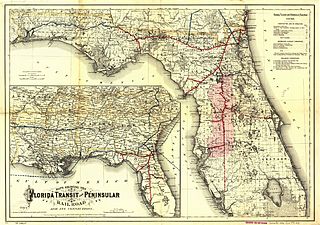
The Southern Railway was a class 1 railroad based in the Southern United States between 1894 and 1982, when it merged with the Norfolk and Western Railway (N&W) to form the Norfolk Southern Railway. The railroad was the product of nearly 150 predecessor lines that were combined, reorganized and recombined beginning in the 1830s, formally becoming the Southern Railway in 1894.

The Seaboard Air Line Railroad, which styled itself as "The Route of Courteous Service", was an American railroad that existed from April 14, 1900, until July 1, 1967, when it merged with the Atlantic Coast Line Railroad, its longtime rival, to form the Seaboard Coast Line Railroad. Predecessor railroads dated from the 1830s and reorganized extensively to rebuild after the American Civil War. The company was headquartered in Norfolk, Virginia, until 1958, when its main offices were relocated to Richmond, Virginia. The Seaboard Air Line Railway Building in Norfolk's historic Freemason District still stands and has been converted into apartments.
The Alabama Midland Railway was incorporated in Alabama and Georgia in 1887, and built a line from Bainbridge, Georgia, to a point near Montgomery, Alabama. The route was completed in 1890. It became part of the Plant System in 1894, and in 1901 it was merged into the Savannah, Florida and Western Railway.

The Florida Central and Peninsular Railroad was the final name of a system of railroads throughout Florida, becoming part of the Seaboard Air Line Railway in 1900. The system, including some of the first railroads in Florida, stretched from Jacksonville west through Tallahassee and south to Tampa. Much of the FC&P network is still in service under the ownership of CSX Transportation.

The Plant System, named after its owner, Henry B. Plant, was a system of railroads and steamboats in the U.S. South, taken over by the Atlantic Coast Line Railroad in 1902. The original line of the system was the Savannah, Florida and Western Railway, running across southern Georgia. The Plant Investment Company was formed in 1882 to lease and buy other railroads and expand the system. Other major lines incorporated into the system include the Savannah and Charleston Railroad and the Brunswick and Western Railroad.

The Atlantic and Gulf Railroad was chartered in February 1856 by act of the Georgia General Assembly. It was also known as the Main Trunk Railroad. It traversed south Georgia from Screven to Bainbridge, Georgia. Construction began in early January 1859. Its construction was halted by the American Civil War. Construction began again after the end of the war and the line was completed to Bainbridge, Georgia by late December 1867. The route never reached all the way to the Gulf of Mexico as it had originally had intended. The company went bankrupt in 1877 and was bought in 1879 by Henry B. Plant and became incorporated into his Plant System. Its main line is currently operated by CSX Transportation. Throughout its history, the Atlantic and Gulf was closely associated with the Savannah and Albany Railroad Company and its successor the Savannah, Albany, and Gulf Railroad.

The Central of Georgia Railway started as the Central Rail Road and Canal Company in 1833. As a way to better attract investment capital, the railroad changed its name to Central Rail Road and Banking Company of Georgia. This railroad was constructed to join the Macon and Western Railroad at Macon, Georgia, in the United States, and run to Savannah. This created a rail link from Chattanooga, on the Tennessee River, to seaports on the Atlantic Ocean. It took from 1837 to 1843 to build the railroad from Savannah to the eastern bank of the Ocmulgee River at Macon; a bridge into the city was not built until 1851.
The Savannah and Northwestern Railway was a railroad in the U.S. state of Georgia. From 1906 to 1914, it was named the Brinson Railway after its owner, George M. Brinson, a businessman who had earlier built the Stillmore Air Line Railway. The line was originally planned to run from Savannah to Sylvania and had completed from Savannah to Newington by 1909. Around this time the Brinson took over the Savannah Valley Railroad and merged its lines into the Brinson. The company's property was sold to the Savannah and Atlanta Railway on July 16, 1917.

The Savannah and Statesboro Railway began in 1897 through a reorganization of the Cuyler and Woodburn Railroad. By 1899, it operated about 33 miles (53 km) of track between Cuyler and Statesboro, Georgia, United States. The S&S also controlled the Savannah, Augusta and Northern Railway from 1911 until 1916 when the SA&N was taken over by the Midland Railway.
The Savannah, Augusta and Northern Railway began operations around 1908, running from Statesboro, Georgia to Garfield, Georgia. It was in the process of building from Garfield to Stevens Crossing, Georgia when in went into receivership and was sold to new owners around 1910. Apparently, the line retained the name under the new ownership however the line was being operated by the Savannah and Statesboro Railway from 1911 to 1915.
The Statesboro Northern Railway began operating in 1924 on 44 miles of former Midland Railway between Statesboro, Georgia and Stevens Crossing, Georgia. It was immediately leased by the Georgia and Florida Railway, and was completely abandoned in 1950.
Stevens Crossing, Georgia, is a small rural community in northeastern Emanuel County, approximately 2 miles north of Summertown, Georgia, and 3 miles south of the Ogeechee River at Midville, Georgia, along Georgia Highway 56. The community of Stevens Crossing was named after the junction of the Midland Railway (Georgia) with the Georgia and Florida Railroad (1926–63) mainline that was constructed on the land of Ben B. Stevens in the early 1900s. A United States Post Office at Stevens Crossing, and a Georgia & Florida depot at Stevens Crossing began operations in 1914, as did the Sutton and Stevens saw mill. The post office ceased operations in March 1939; the Stevens Crossing to Statesboro line was abandoned in 1950, and the depot and the old Midland Railway tracks removed several years later. In 2004, the Heart of Georgia Railroad subleased the portion of the old Georgia & Florida mainline that ran from Midville, Georgia to Vidalia, Georgia . Today, several descendants of the Stevens and Coleman families live in the community, and the community is also home to the Stevens Crossing Dove Club, owned and operated by a grandson of Ben B. Stevens. The Stevens Family Cemetery is located about one half mile west of the actual old crossing on Stevens Cemetery Road.
The Savannah, Americus and Montgomery Railway (SA&M) was a historic railroad located in the U.S. states of Georgia and Alabama. SA&M was built in the 1880s running between Montgomery, Alabama and Lyons, Georgia. It would be completed to Savannah, Georgia in 1896 after being renamed the Georgia and Alabama Railway. The line would notably become part of the Seaboard Air Line Railroad network in 1900.

The Georgia Midland Railroad was a shortline railroad that operated several lines in Georgia that it acquired in 2004 from the initial operations of Ogeechee Railway. In 2009 the Georgia Midland was purchased by Pioneer RailCorp from Atlantic Western Transportation Company, the holding company for the Heart of Georgia Railroad. Pioneer renamed the railroad as the Georgia Southern Railway. Hauling an average of 5000 carloads per year of aggregate sand, stone, farm products and wood, the Georgia Midland Railroad connected with the Norfolk Southern Railway.

The Riceboro Southern Railway began operations in 2004 operating on about 33 miles of track, some of which is leased from CSX Transportation. The track on which it operates is part of the ex-Seaboard Air Line route from Savannah, Georgia to Jacksonville, Florida. It runs generally from Ogeechee, Georgia, where the line splits from the CSX Savannah Subdivision, which is the former Atlantic Coast Line Railroad's Savannah-Jacksonville route, and Riceboro. It does not have any of its own locomotives; it uses Georgia Central power.

The First Coast Railroad is a class III railroad operating in Florida and Georgia, owned by Genesee & Wyoming. The name is derived from its area of operations around the First Coast of Florida.

State Route 26 (SR 26) is a 271.1-mile-long (436.3 km) state highway that travels west-to-east through portions of Chattahoochee, Marion, Schley, Macon, Houston, Pulaski, Bleckley, Laurens, Johnson, Emanuel, Bulloch, Bryan, Effingham, and Chatham counties through the central part of the U.S. state of Georgia. It crosses nearly the entire width of the state, connecting Cusseta, on the southeastern edge of Fort Moore, near Columbus to Tybee Island on the Atlantic coast near Savannah, via Buena Vista, Ellaville, Oglethorpe, Hawkinsville, Cochran, Dublin, Swainsboro, Statesboro, and Savannah.










